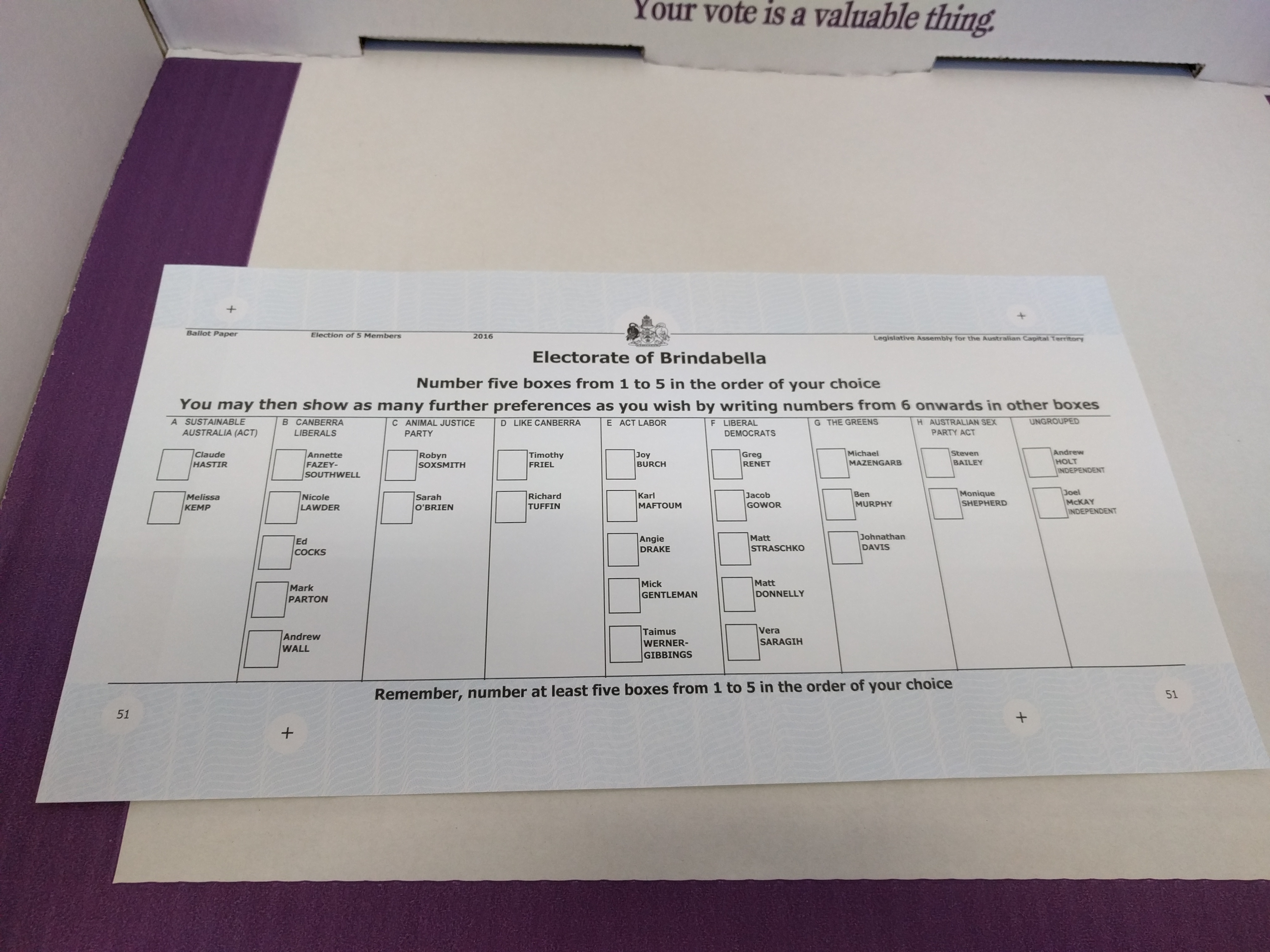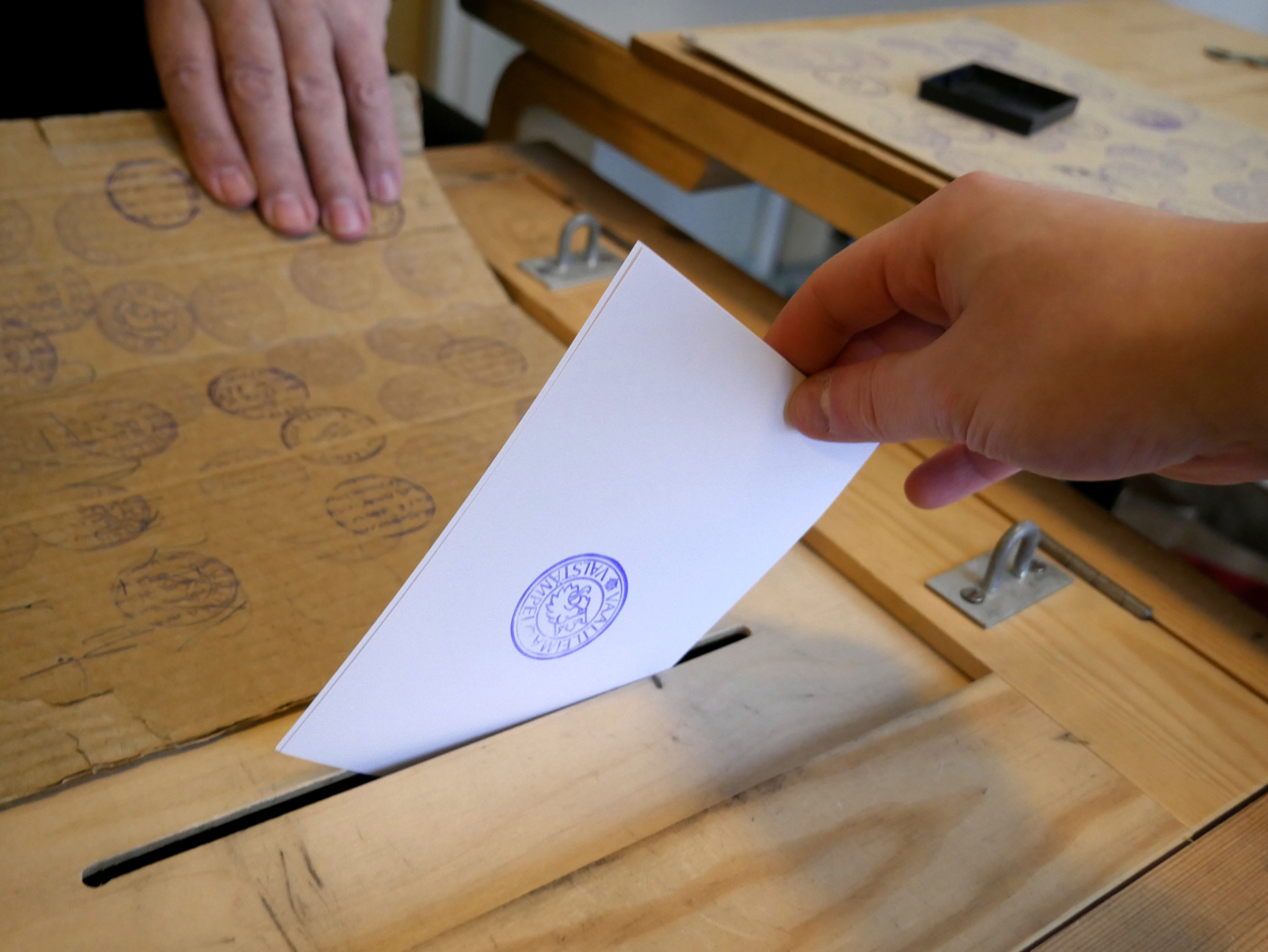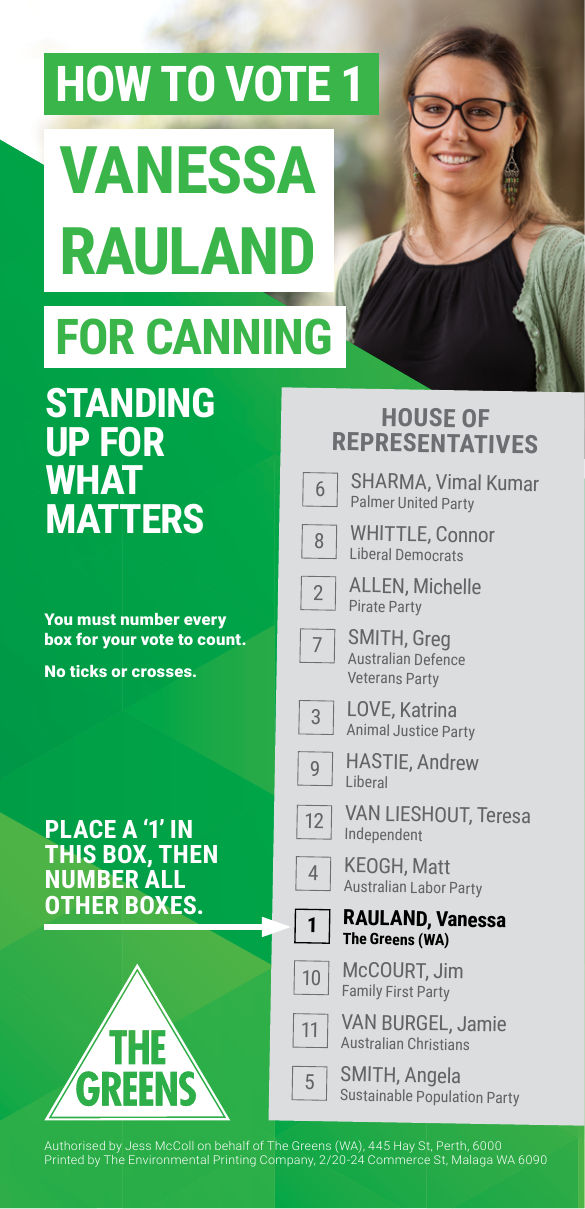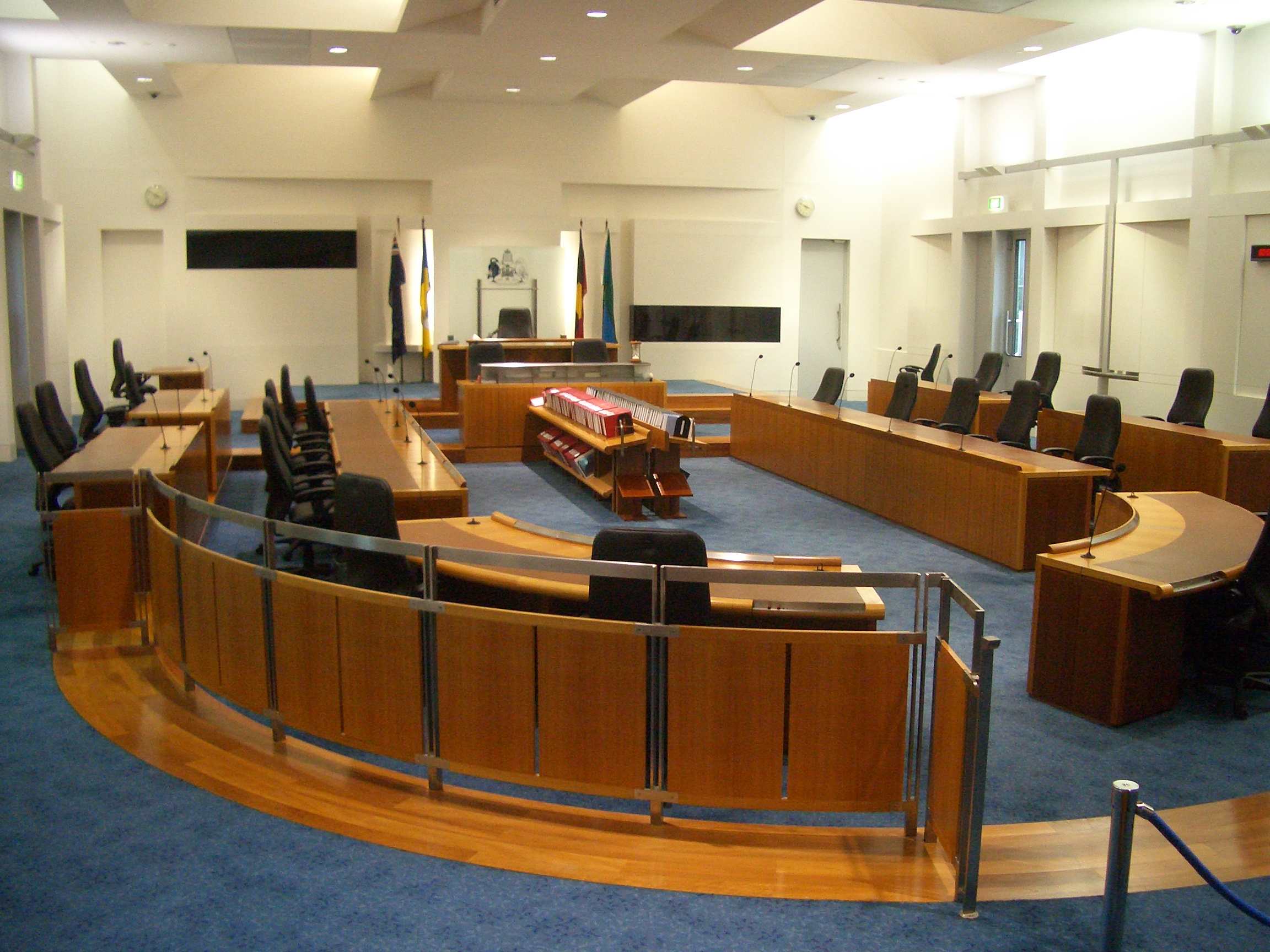|
Hare–Clark Electoral System
Hare–Clark is a type of single transferable vote electoral system of proportional representation used for elections in Tasmania and the Australian Capital Territory. It was one of the first uses of the Gregory method for transfers of winner's surplus votes. The name is derived from the names of English barrister Thomas Hare, the original inventor of single transferable voting, and Attorney-General of Tasmania Andrew Inglis Clark, who introduced a modified form to Tasmania in 1896. History Thomas Hare (1806–91) is generally credited with the conception of the single transferable vote, while Andrew Inglis Clark (1848–1907) introduced the system to Tasmania with a modified counting method. "The specific modification introduced by Mr. A.I. Clark, Attorney-General for Tasmania, is the provision devised by him for eliminating the element of chance in the selection and distribution of quota-excesses or surplus transfer votes." The provision described as "Clark's own" was the G ... [...More Info...] [...Related Items...] OR: [Wikipedia] [Google] [Baidu] |
Ballot Paper For The 2016 ACT Election
A ballot is a device used to cast votes in an election and may be found as a piece of paper or a small ball used in voting. It was originally a small ball (see blackballing) used to record decisions made by voters in Italy around the 16th century. Each voter uses one ballot, and ballots are not shared. In the simplest elections, a ballot may be a scrap of paper on which each voter writes in the name of a candidate, but governmental elections use printed ballots to protect the secrecy of the votes. The voter casts their ballot in a box at a polling station. In British English, this is usually called a "ballot paper". The word ''ballot'' is used for an election process within an organization (such as a trade union "holding a ballot" of its members). Etymology The word ballot comes from Italian ''ballotta'', meaning a "small ball used in voting" or a "secret vote taken by ballots" in Venice, Italy. History In ancient Greece, citizens used pieces of broken pottery to scratch in ... [...More Info...] [...Related Items...] OR: [Wikipedia] [Google] [Baidu] |
Division Of Tasmania
The Division of Tasmania was an Divisions of the Australian House of Representatives, Australian electoral division covering Tasmania. The five-member statewide seat existed from the inaugural 1901 Australian federal election, 1901 election until the 1903 Australian federal election, 1903 election. Each elector cast one vote. Unlike most of the other states, Tasmania had not been split into individual single-member electorates. The other exception was the seven-member Division of South Australia. The statewide seats were abolished at a redistribution conducted two months prior to the 1903 election and were subsequently replaced with single-member divisions, one per displaced member, with each elector now casting a single vote. Members ''Sorted in order of votes received'' The Division was split into five single-member district, single-member seats at the 1903 Australian federal election, 1903 election – Division of Bass, Bass (David Storrer, Storrer, Protectionist), Division ... [...More Info...] [...Related Items...] OR: [Wikipedia] [Google] [Baidu] |
Droop Quota
In the study of Electoral system, electoral systems, the Droop quota (sometimes called the Eduard Hagenbach-Bischoff, Hagenbach-Bischoff, Britton, or Newland-Britton quota) is the Infimum, minimum number of votes a party or candidate needs to receive in a district to guarantee they will win at least one seat. Reprinted in ''Voting matters Issue 24'' (October 2007) pp. 7–46. The Droop quota is used to extend the concept of a majority to multiwinner elections, taking the place of the 50% bar in single-winner elections. Just as any candidate with more than half of all votes is guaranteed to be declared the winner in single-seat election, any candidate with more than a Droop quota's worth of votes is guaranteed to win a seat in a Multiwinner voting, multiwinner election. Besides establishing winners, the Droop quota is used to define the number of excess votes, i.e. votes not needed by a candidate who has been declared elected. In proportional electoral quota, quota-based syste ... [...More Info...] [...Related Items...] OR: [Wikipedia] [Google] [Baidu] |
How-to-vote Card
In Australia, how-to-vote cards (HTV) are small leaflets that are handed out by party supporters during elections. Voting in the Australian lower house uses a preferential voting system. Voters must rank every candidate on the ballot in order for their vote to count. There are often numerous candidates on the ballot, some with little public profile, so voters may find it difficult to decide on all of them. Parties produce how-to-vote cards ostensibly to help voters. They contain details about the candidate or party, as well as instruction on how to cast a ranked vote in the order that the party would prefer the voter follow. The flow of preferences can assist the party dispersing the cards directly and indirectly help allied parties. The use of HTV cards have benefited minor parties in a number of ways including increasing their chances of winning, punishing opponents and receiving policy commitments. Sometimes "preference deals" are done between political parties so that the ... [...More Info...] [...Related Items...] OR: [Wikipedia] [Google] [Baidu] |
Victoria (state)
Victoria, commonly abbreviated as Vic, is a States and territories of Australia, state in southeastern Australia. It is the second-smallest state (after Tasmania), with a land area of ; the second-most-populated state (after New South Wales), with a population of over 7 million; and the most densely populated state in Australia (30.6 per km2). Victoria's economy is the List of Australian states and territories by gross state product, second-largest among Australian states and is highly diversified, with service sectors predominating. Victoria is bordered by New South Wales to the north and South Australia to the west and is bounded by the Bass Strait to the south (with the exception of a small land border with Tasmania located along Boundary Islet), the Southern Ocean to the southwest, and the Tasman Sea (a marginal sea of the South Pacific Ocean) to the southeast. The state encompasses a range of climates and geographical features from its temperate climate, temperate coa ... [...More Info...] [...Related Items...] OR: [Wikipedia] [Google] [Baidu] |
ABC News (Australia)
ABC News, also known as ABC News and Current Affairs, is a public news service produced by the Australian Broadcasting Corporation. The service covers both local and world affairs, broadcasting both nationally as ABC News, and across the Asia-Pacific under the ''ABC Australia'' title. The division of the organisation ABC News, Analysis and Investigations is responsible for all news-gathering and coverage across the Australian Broadcasting Corporation's various television, radio, and online platforms. Some of the services included under the auspices of the division are its 24-hour news channel ABC News Australia TV Channel (formerly ABC News 24), the long-running radio news programs, '' AM'', '' The World Today'', and '' PM''; ABC NewsRadio, a 24-hour continuous news radio channel; and radio news bulletins and programs on ABC Local Radio, ABC Radio National, ABC Classic FM, and Triple J. ABC News Online has an extensive online presence which includes many written news ... [...More Info...] [...Related Items...] OR: [Wikipedia] [Google] [Baidu] |
2016 Australian Federal Election
The 2016 Australian federal election was a double dissolution election held on Saturday, 2 July 2016, to elect all 226 members of the 45th Parliament of Australia, 45th Parliament of Australia, after an extended eight-week official campaign period. It was the first double dissolution election since the 1987 Australian federal election, 1987 election and the first under a new voting system for the Australian Senate, Senate that replaced group voting tickets in Australia, group voting tickets with Single transferable vote#Australia, optional preferential voting. In the 150-seat House of Representatives, the one-term incumbent Coalition government was reelected with a reduced 76 seats, marking the first time since 2004 Australian federal election, 2004 that a government had been reelected with an absolute majority. Labor picked up a significant number of previously government-held seats for a total of 69 seats, recovering much of what it had lost in its severe defeat of 2013 Aust ... [...More Info...] [...Related Items...] OR: [Wikipedia] [Google] [Baidu] |
Donkey Vote
In electoral systems which use ranked voting, a donkey vote is a cast ballot where the voter ranks the candidates based on the order they appear on the ballot itself. The voter that votes in this manner is referred to as a donkey voter. Typically, this involves numbering the candidates in the order they appear on the ballot paper: first preference for the first-listed candidate, second preference for the second-listed candidate, and so on. However, donkey votes can also occur in reverse, such that someone numbers the candidates from the bottom up the ballot paper. In systems where a voter is required to place a number against each candidate for the vote to be valid, the voter may give the first preference to the candidate they prefer, then run all the other numbers donkey fashion. Donkey votes are most common where preference voting is combined with compulsory voting, such as in Australia, particularly where all candidates must be ranked on the ballot paper. There are differ ... [...More Info...] [...Related Items...] OR: [Wikipedia] [Google] [Baidu] |
Robson Rotation
Robson Rotation is an Australian term for the practice of rotating the order of candidates' names during the printing of the ballot papers for an election, so that the advantage of being listed near the start of the ballot is spread equally among all candidates. Such an advantage is particularly strong in elections in Australia, where the combination of single transferable vote and compulsory voting leads many politically apathetic voters to cast a " donkey vote" ranking the candidates in the order in which they are listed. Robson Rotation, first used in the Tasmanian House of Assembly in the 1980 Denison by-election, is named after Neil Robson, then Liberal member for Bass. It was adopted in Australian Capital Territory elections in 1995. Traditionally, every ballot paper in an election is identical, with the candidates' names and their party groups (if any) in the same order. Within the party or group ticket, the order of their candidates' names is decided by the group. ... [...More Info...] [...Related Items...] OR: [Wikipedia] [Google] [Baidu] |
Australian Dictionary Of Biography
The ''Australian Dictionary of Biography'' (ADB or AuDB) is a national co-operative enterprise founded and maintained by the Australian National University (ANU) to produce authoritative biographical articles on eminent people in Australia's history. Initially published by Melbourne University Press in a series of twelve hard-copy volumes between 1966 and 2005, the dictionary has been published online since 2006 by the National Centre of Biography (NCB) at ANU, which has also published ''Obituaries Australia'' (OA) since 2010. History The ADB project began operating in 1957, although preparation work had been started in about 1954 at the Australian National University. An index was created that would be the basis of the ADB. Pat Wardle was involved in the work and, in time, she herself was included in the ADB. Staff are located at the National Centre of Biography in the History Department of the Research School of Social Sciences at the Australian National University. Since i ... [...More Info...] [...Related Items...] OR: [Wikipedia] [Google] [Baidu] |
Australian Capital Territory Legislative Assembly
The Legislative Assembly for the Australian Capital Territory, known in short as the ACT Legislative Assembly, is the unicameral legislature of the Australian Capital Territory (ACT). It sits in the Legislative Assembly Building, Canberra, Legislative Assembly Building on Civic Square, close to City, Australian Capital Territory, the centre of the city of Canberra. Unlike the legislatures of the other mainland states and territories, the Assembly also has the functions of a local council; the city of Canberra has no other local government. It replaced the Australian Capital Territory House of Assembly, House of Assembly when the ACT was granted self-government in 1986. Voters had previously rejected self government in a 1978 plebiscite. Structure and Membership The Legislative Assembly has 25 members, elected from five electorates ― Brindabella electorate, Brindabella, Ginninderra electorate, Ginninderra, Kurrajong electorate, Kurrajong, Murrumbidgee electorate, Murrumbidgee ... [...More Info...] [...Related Items...] OR: [Wikipedia] [Google] [Baidu] |
1927 New South Wales State Election
The 1927 New South Wales state election to elect the 90 members of the 28th Legislative Assembly was held on 8 October 1927. During the previous parliament the voting system, Single transferable voting, a form of proportional representation with multi-member seats (Single transferable vote, modified Hare-Clark), had been changed to single member constituencies and Instant-runoff voting (optional preferential voting). Severe divisions occurred within the Australian Labor Party (New South Wales Branch), Labor Party caucus in the four months prior to the election (see Lang Labor). A caretaker government composed of the supporters of the Premier of New South Wales and Leader of the Australian Labor Party in New South Wales, party leader, Jack Lang (Australian politician), Jack Lang was in power at the time of the election. As a result of the election the Lang government was defeated and a Nationalist/Country Party coalition government led by Thomas Bavin and Ernest Buttenshaw was f ... [...More Info...] [...Related Items...] OR: [Wikipedia] [Google] [Baidu] |








